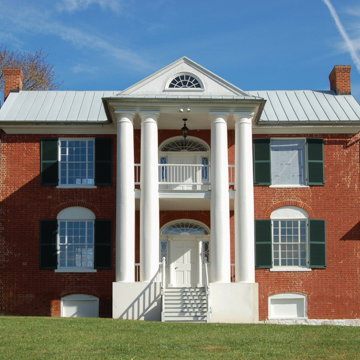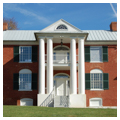You are here
Paxton House (Glenn Maury)
Built by Elisha Paxton, a prosperous local farmer whose family settled in the area in the eighteenth century, this house blends traditional Valley forms with newer ideas from Greek Revival. Traditional features include the central-passage, single-pile plan, its bank-sited two-story arrangement with rear ell, and the molded brick cornice on the rear of the main block and the ell. All of these are elements found on high-style houses in the Valley in the early nineteenth century. Greek Revival features include the two-story, coupled, Doric-columned porch with pediment and the arched, tripartite windows. The interior woodwork is especially elaborate, indicating the wealth and ambition of its owner. In 2007 the Victorian-era, double-galleried side porch was restored and later additions removed from the ell. Located on the banks of the Maury (North) River and once the center of a large plantation, it now serves as a community center for the Buena Vista city park and a home for the Paxton House Historical Society.
Writing Credits
If SAH Archipedia has been useful to you, please consider supporting it.
SAH Archipedia tells the story of the United States through its buildings, landscapes, and cities. This freely available resource empowers the public with authoritative knowledge that deepens their understanding and appreciation of the built environment. But the Society of Architectural Historians, which created SAH Archipedia with University of Virginia Press, needs your support to maintain the high-caliber research, writing, photography, cartography, editing, design, and programming that make SAH Archipedia a trusted online resource available to all who value the history of place, heritage tourism, and learning.





